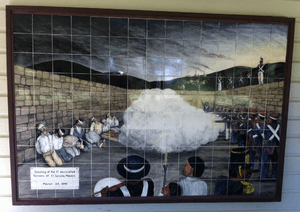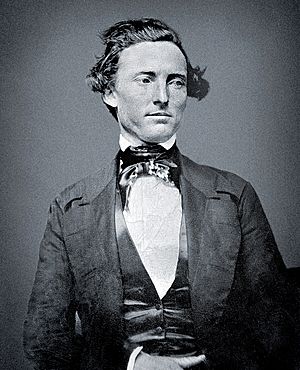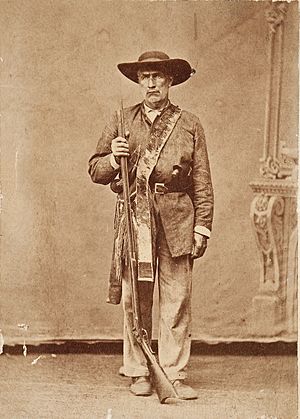Mier expedition facts for kids
Quick facts for kids Mier expedition |
|||||||
|---|---|---|---|---|---|---|---|
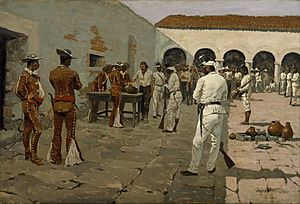 The Drawing of the Black Bean, Frederic Remington |
|||||||
|
|||||||
| Belligerents | |||||||
| Commanders and leaders | |||||||
| Strength | |||||||
| 836 | 750 | ||||||
| Casualties and losses | |||||||
| 40 killed 60 wounded |
64 killed and wounded 242 captured |
||||||
The Mier Expedition was a military operation that didn't go well. It was started in November 1842 by a group of Texan soldiers against Mexican towns near the border. This event was connected to another mission called the Somervell Expedition.
A major battle happened at Ciudad Mier on December 26 and 27, 1842. The Mexican forces won this battle. The Texans launched their attack for a few reasons. They hoped to gain money and wanted to get revenge for the Dawson Massacre. In that event, earlier in the year, 36 Texan soldiers were killed by the Mexican Army. Both conflicts were part of a bigger fight. Both sides wanted to control the land between the Rio Grande and Nueces River. The Republic of Texas believed this land was theirs. They thought it was given to them in the Treaties of Velasco, which made Texas independent. But Mexico did not agree with this.
Contents
Why the Expedition Happened
Antonio López de Santa Anna was the leader of Mexico. Texan forces defeated him at the Battle of San Jacinto in 1836. After this, he signed the Treaties of Velasco. These treaties gave Texas territory to the Texans. However, the Mexican government never officially approved these treaties.
Mexican forces kept invading the Republic of Texas. Their goal was to take back control. They especially wanted the land between the Rio Grande and Nueces River. Texas had very few settlements in this area.
On September 17, 1842, Texan and Mexican forces met. This happened at Salado Creek, east of San Antonio. Earlier that day, Texans had won a small fight. Then, a group of 54 Texan soldiers arrived. They were mostly from Fayette County. Nicholas Mosby Dawson led this group. They were moving toward the back of the Mexican Army.
The Mexican commander, General Adrián Woll, sent 500 cavalrymen to attack them. He also sent two cannons. The Texans fought bravely against the Mexican soldiers. But they started losing more men when the cannons got close enough to fire. The battle lasted just over an hour. It resulted in 36 Texans dead and 15 captured. Texans called this event the Dawson Massacre.
The Expeditions Begin
On November 25, 1842, Alex Somervell and 700 Texan soldiers left for San Antonio. They wanted to punish the Mexican army for raiding parts of Texas. By December 7, 1842, the soldiers had taken back control of Laredo, a city in Texas.
On the same day, Alex Somervell and his soldiers took over the town of Guerrero. By the time they took over Guerrero, only 500 soldiers were left. Many had left after taking Laredo. Because they had fewer soldiers, Somervell ordered his men to return home. This order was given on December 19, 1842.
However, some men did not follow the order. More men joined the Texan force at La Grange. They then marched to Ciudad Mier. William S. Fisher was their new commander. This part of the expedition then failed.
Battle of Mier
| Battle of Mier | |||||||
|---|---|---|---|---|---|---|---|
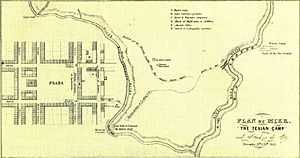 A map of the Battle at Ciudad Mier |
|||||||
|
|||||||
| Belligerents | |||||||
| Commanders and leaders | |||||||
| Strength | |||||||
| 836 | 350 | ||||||
| Casualties and losses | |||||||
| 40 killed 60 wounded |
64 killed and wounded 242 captured |
||||||
Sam Houston ordered the Texan forces to move back. He wanted them to go from the Rio Grande to Gonzales. But only 400 soldiers followed this order. On December 20, 1842, the remaining 350 Texan soldiers moved closer to Ciudad Mier. William S. Fisher led them. They set up camp on the Texas side of the Rio Grande. Then, they went to capture the town.
The Texans did not know how many Mexican troops were in the town. Once inside the city, Mexican soldiers attacked the Texans from the sides. The Texans were surrounded. They eventually surrendered to avoid a complete slaughter.
The Mexican army took 243 Texans as prisoners. They marched them toward Mexico City. Their long journey took them through Matamoros, Tamaulipas, and Monterrey, Nuevo León.
On February 11, 1843, 181 Texans managed to escape. But by the end of the month, most were recaptured. There was not enough food or water in the Mexican desert mountains. This happened near Salado, Tamaulipas.
When the prisoners reached Saltillo, Coahuila, they heard bad news. Santa Anna was very angry. He had ordered that all the escapees be executed. But General and Governor Francisco Mejia of Coahuila refused to follow this order. The new commander, Colonel Domingo Huerta, moved the prisoners to El Rancho Salado.
By this time, the United States and Great Britain were trying to help Texas. Their foreign ministers talked to Santa Anna. He then agreed to a compromise. He said that one out of every ten prisoners would be killed.
The Black Bean Episode
To decide who would die, Huerta used a pot with beans. He put 159 white beans and 17 black beans in it. This event became known as the Black Bean Episode or the Bean Lottery. The Texans were blindfolded. They were then ordered to draw a bean. Officers and regular soldiers drew in alphabetical order.
The seventeen men who drew black beans were allowed to write letters home. Then, they were executed by a firing squad. This happened on the evening of March 25, 1843. The Texans were shot in two groups. One group had nine men, and the other had eight. A story says that Huerta put the black beans in the jar last. He also made the officers pick first. This way, most of those killed would be officers.
The first Texan to draw a black bean was Major James Decatur Cocke. A witness remembered Cocke holding up the bean. He held it between his finger and thumb. With a look of scorn, he said, "Boys, I told you so; I never failed in my life to draw a prize." He later told a friend, "They only rob me of forty years." He was worried the Mexicans would take his clothes after he died. So, he took off his pants and gave them to a friend whose clothes were in worse shape. He was shot with the sixteen others on March 25, 1843. His last words were said to be, "Tell my friends I die with grace."
The other sixteen who drew black beans were William Mosby Eastland, Patrick Mahan, James M. Ogden, James N. Torrey, Martin Carroll Wing, John L. Cash, Robert Holmes Dunham, Edward E. Este, Robert Harris, Thomas L. Jones, Christopher Roberts, William N. Rowan, James L. Shepherd, J. N. M. Thomson, James Turnbull, and Henry Walling. James L. Shepherd survived the firing squad. He pretended to be dead. The guards left him in the courtyard. He escaped that night but was caught again and shot. Eastland County, Texas, is named after William Mosby Eastland.
Captain Ewen Cameron had drawn a white bean. But Santa Anna ordered him executed anyway. This happened a month later while Cameron was held at Perote Prison. As he waited to die, Cameron refused to confess to a priest.
The survivors who picked white beans included Bigfoot Wallace and Samuel Walker. They finished the march to Mexico City. Later, they were imprisoned at Perote Prison. This prison was in the state of Veracruz. Also there were the 15 survivors of the Dawson Massacre. About 35 other men captured by General Adrián Woll in San Antonio were also held there. Some Texans escaped from Perote, or they died there. Most were prisoners until Santa Anna ordered their release. This happened on September 16, 1844.
What Happened After (Legacy)

In 1847, the U.S. Army took control of northeastern Mexico. This was during the Mexican–American War. Captain John E. Dusenbury, who had drawn a white bean and survived, went back to El Rancho Salado. He dug up the remains of his friends. He then traveled with the remains on a ship to Galveston. From there, he took a wagon to La Grange in Fayette County, Texas.
Citizens of La Grange also got the remains of the men killed in the Dawson Massacre. They brought them from their burial site near Salado Creek in Bexar County.
The remains of both groups of men were buried again in a special ceremony. About 1,000 people attended. They were buried in a large shared tomb in 1848. It was a cement vault on a hill one mile south of La Grange. This burial site is now part of a state park. It is called the Monument Hill and Kreische Brewery State Historic Sites.
The Black Bean Episode is shown in a famous painting. It is by Frederic Remington. The painting is called The Mier Expedition: The Drawing of the Black Bean.
See also
 In Spanish: Expedición Mier para niños
In Spanish: Expedición Mier para niños


